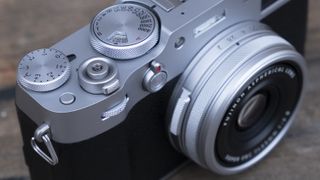Fujifilm X100R: what to expect from the rumored X100V successor
It's been almost four years since the launch of the Fujifilm X100V, a unique compact camera with retro style, a sharp sensor and a fixed 23mm lens. It's still our favorite compact camera and one of the best travel cameras you can buy. Which only makes the prospect of a sequel even more appealing.
If the rumors are true, Fujifilm is building towards the launch of its successor, which will most likely be called the 'X100R'. Better yet, it is heavily speculated that the release will take place in early 2024. But with such special shoes to fill, the real question is what the next installment in the X100 lineup will look like.
To give you an overview of what to expect, we've collected all the information currently circulating online about the Fujifilm X100R. From release date to features, you'll find all the latest X100R news below.
We've also given our verdict on which upgrades we think are most likely to make it into production, and which features we'd most like to see.
Fujifilm X100R: release date and price rumors
The Fujifilm X100V hit the shelves for $1399 / £1299 / AU$2,349. Adjusted for inflation, these figures are virtually the same as the launch price of its predecessor, the X100F.
If Fujifilm follows that trend, we could see the rumored X100R priced at $1599 / £1499 / AU$2649. That would place it firmly in the mirrorless mid-range, alongside models like the Nikon Z6 II. That may seem like tough competition for a premium compact camera, but the continued popularity of the X100 series – fueled in part by recent TikTok trends – means Fuji is probably safe from jacking up the asking price.
It's also worth noting that the above prices are pure speculation, as there's no clear word on what the X100R will cost when it potentially launches.
As for a release date, Fuji Rumors – which has a relatively good track record when it comes to predictions – has reported that the X100R will break through coverage “in early 2024.” This ties in with the last two iterations of the X100: the X100F launched in January 2017, followed by the X100V in February 2020.
When exactly in the first few months of 2024 remains to be seen. This also applies to the name: although many sources use X100R as the label (derived from rokuthe Japanese word for six), there is a good chance that the sixth part in the series will have a different name, such as X100VI.
Fujifilm X100R: Design and build
Two things have always been true of Fuji's X100 series: the retro-inspired design and the fixed 23mm prime lens. Both will almost guarantee returns on the so-called X100R.
The series has always championed premium build quality and excellent physical controls, with plenty of instantly accessible dials and buttons. That's unlikely to change with the X100R, especially given the near-cult status the X100V now enjoys.
That same camera saw the neat introduction of a tilting touchscreen, without compromising the established look and feel of the X100 series. The logical evolution of this interface would be a fully articulating touchscreen: since X100 cameras are tailor-made for shooting from the hip, a vari-angle display would give street photographers even more flexible framing options. The question is whether such a monitor can be integrated without adding bulk.
Another upgrade posited by some commentators is a switch from magnesium alloy to titanium for the body construction. In reality, this is more of a luxury than a necessity, and one that would only drive up the price. We prefer to see the X100R with full weather sealing, without the need for a filter around the lens.
Fuji Rumors has also floated the idea of a “new” lens for the X100R, although it's unclear what form this might take. We think it is very unlikely that Fuji will abandon the established 23mm f/2 format. It's more realistic to expect the X100R to follow the X100V's lead and refine the internals to deliver a sharper recording experience.
Fujifilm X100R: sensor and performance
We called the X100V “the best of its kind” and the X100F “the perfect camera for enthusiasts.” So the next in line has tough tasks to follow when it comes to image performance. A safe place to start is with a basic X100 series product: a large APS-C sensor.
The X100V used the same 26.1 MP X-Trans IV sensor and X-Processor 4 chip as the X-T4. If the X100R were to follow suit and borrow its sensor from the X-T5 (and, by extension, the X100 series camera. This would give the X100R huge potential for such a compact model.
However, there is an alternative. Fuji could stick to the X100V's 26MP standard and equip the X100R with the X-H2S's stacked 26.1MP APS-C sensor. Combined with the X-Processor 5 (which will almost certainly be used) this would make big gains in burst shooting speeds and autofocus performance – although the
We've seen stacked sensors in premium compact cameras before, most notably the Sony RX100 VII. But that was a 1-inch number, not APS-C – so the X100R would be groundbreaking. The question mark hangs over the costs: the X-H2S is a solid price point above the X100 series, and stacked APS-C sensors are usually not cheap. So it might be unrealistic to expect Fuji to put the same technology into the X100R.
Either way, both sensors represent an intriguing possibility. Each of these cameras is said to offer a shooting experience never before seen in a portable premium compact camera.
When it comes to video, the X100 series has always been about photography first. So we don't expect the X100R to have 6K or internal 10-bit 4:2:2 capabilities. That said, we still expect the shooting data for the X100R to improve – especially in an era where content creation is crucial. Where maximum 4K frame rates for the X100V topped out at 30fps, we think the X100R will record footage at a minimum of 60fps.
Fujifilm X100R: features
Another feature of the X100 series is the hybrid viewfinder, which allows you to switch between a traditional optical viewfinder and a modern EVF. It's a clever party trick that bridges the gap between old and new and reflects the camera's approach as a whole. Expect it to return for the X100R, albeit with a few tweaks.
The EVF was already boosted to 3.69 million dots on the X100V, and we doubt this will be increased again for the X100R. Instead, we hope the EVF magnification improves to 0.7x, from 0.66x on the X100V.
One feature that is missing from all cameras from the X100 series is the image stabilization in the housing. Shooting sharply previously meant relying on the shutter speed/ISO dial, along with the lens's wide aperture – which didn't stop us from capturing sharp results in previous tests. The only thing this approach could change is a greater focus on video, with stabilization becoming more relevant for shooting handheld clips. There is no IBIS intelligence yet.
An easier prediction is a bigger battery: even with the inherent limitations of size, a bigger cell would be an instant win – just like with the X100V. Fujifilm managed to improve battery life in the recent X-S20, from a similar cell to the X-S10.
Film simulation modes are another established feature of the X100 family, and we expect more preset recipes to arrive with the
With the X-Processor 5 inside, the X100R would also benefit from the deep autofocus tricks seen in the likes of the Fujifilm X-S20. This would take the new X100 model beyond the face/eye detection AF of the X100V, into a realm of subject detection that includes animals, vehicles and more.
Together with the improved prediction algorithm also found on the X-S20, this should make it easier to shoot from the hip with the confidence that you're capturing a sharp subject. It would also be the ultimate reflection of the X100R as a camera that celebrates old and new, putting cutting-edge AI autofocus in a body inspired by the analogue era.
Whatever form the so-called X100R takes, it is one of them the long-awaited cameras for 2024.





